Optimizing your website is complex, involving everything from ensuring your site speed is adequate to checking that your online store looks good on mobile devices. Most importantly, you want to ensure that your offers and calls-to-action are converting as well as possible.
Since running an optimized website is such a big job, it’s helpful to break it into several stages or steps. And that’s exactly what we’ve done in this article, where we break website optimization down with 13 essential tips.
Let’s get started!
What is website optimization?
Website optimization is the process of enhancing your website’s performance, user experience, and conversion rates. Essentially, you want to make sure that every element on your web pages contributes to creating a great customer journey.
Website optimization efforts typically involve making improvements at every level of an online store. This means that to fully optimize your website, you should have a plan to improve site structure, perform web development upgrades, and ensure your website content is perfect.
Why should you be focusing on optimization?
In the competitive ecommerce industry, a properly optimized website will help you reach your target audience and stand out. The different parts of your website, like your underlying code and website speed, your technical SEO, and your deals and offers, all need to be functioning at the highest possible level.
When you manage to create an optimized site that’s firing on all cylinders, your website users will notice the difference and you’ll find it much easier to reach your business goals. Website optimization offers benefits like increased traffic, higher conversion rates, and improved customer satisfaction.
This better website performance will boost your ROI by improving both customer acquisition and retention. And, since you can optimize your website continuously, it’s easy to stay up to date on evolving user trends and preferences.
Top 13 optimization tips for ecommerce websites
Each of the website optimization tips on this list can help you convert website visitors into paying customers. You don’t necessarily need to jump in with all of these at once, so keep an eye out for solutions that respond to problems you’re currently experiencing.
1. Focus on your product and landing pages
Your product pages and landing pages are key touchpoints in the customer journey. And that means they’re key pages you’ll want to focus on as you optimize your website.
As a first step, you should ensure that these pages feature compelling product descriptions, high-quality images, and user-friendly navigation.
When website traffic lands on your product pages from organic Google search, ads, and other sources, they should see detailed and persuasive product descriptions that leave no doubt in their mind about the product’s value. High-resolution images can also help these users understand how your products can solve the problem that motivated them to start shopping.
Finally, an intuitive navigation structure ensures that customers can easily find the products they’re looking for, reducing frustration and increasing conversion rates.
How can Smart Product Page Optimizer can help you?
OptiMonk’s Smart Product Page Optimizer is an innovative website performance optimization tool that can turn your product pages into high-converting sales pages without requiring lots of time or money from you. The tool’s simple three-step process can take your product page content to the next level—here’s how it works:
- Decide which elements you want to optimize.
- Review the AI-generated content.
- Launch the campaign and watch your results roll in!

2. Personalize your offers
These days, online shoppers are used to seeing online content that’s tailored to their individual needs and preferences—one-size-fits-all messaging simply won’t cut it anymore.
That’s why personalizing your recommendations based on visitor behavior, website traffic source, or geographic location is a key part of website optimization. Using customer data and website analytics to segment your audience will improve the relevance of your marketing efforts and increase the chances of conversion.
Here’s an example from Obvi that enhances the user experience through personalization:

Check out these advanced personalization templates to copy Obvi’s campaign on your own website.
3. Make the checkout process seamless
A seamless checkout process minimizes cart abandonment rates by eliminating unnecessary steps and distractions. By only asking for essential information, you can make it quick and easy for customers to complete their purchases, ensuring they don’t get frustrated and bounce.
It’s also crucial to offer a variety of payment options, since customers have different preferences about how to pay. This can include credit cards, digital wallets, and even buy-now-pay-later services.
Check out how Asos highlights the payment methods they accept:
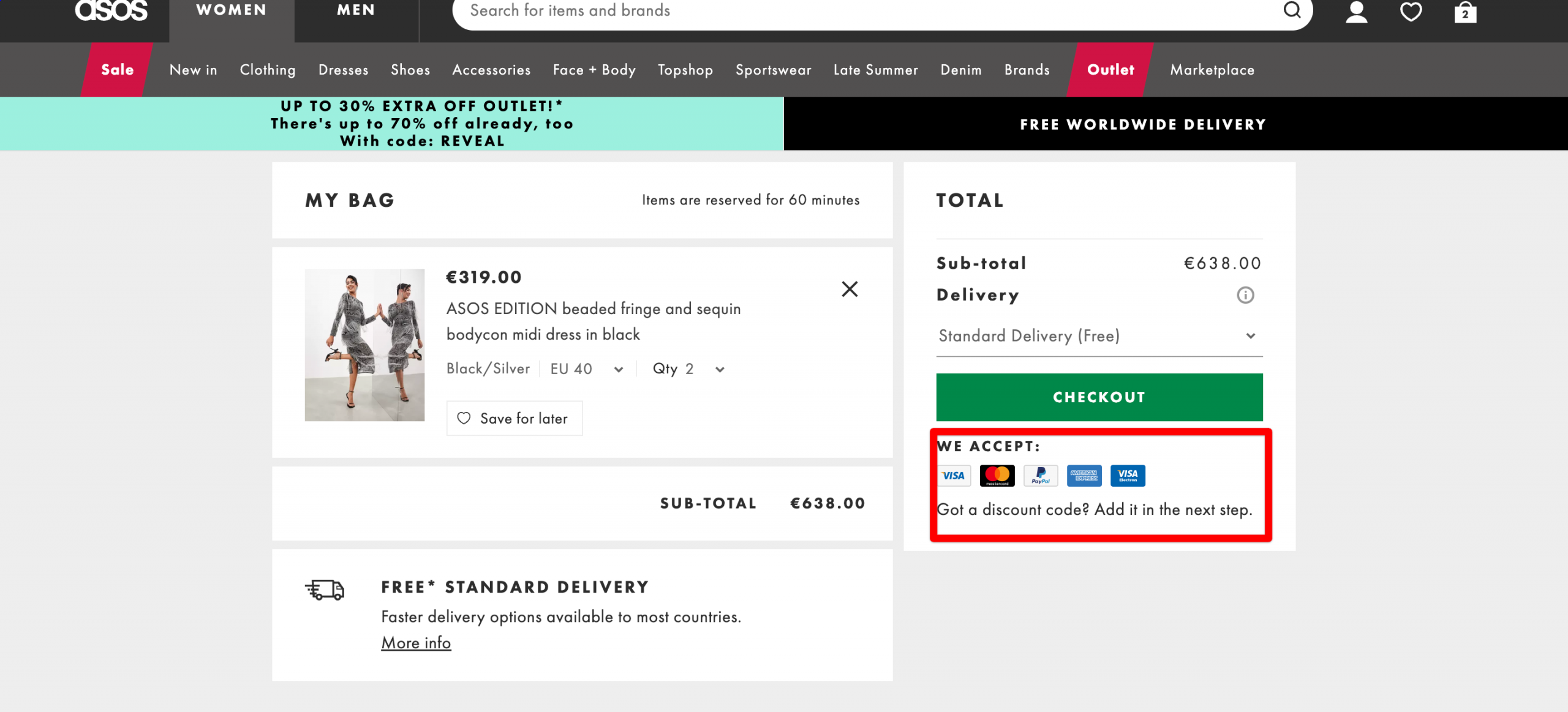
3. Improve page load time
Fast-loading pages provide a much better user experience than pages that load slowly. If a visitor experiences delays while browsing through your online store, they’re unlikely to stay engaged and will probably bounce sooner rather than later. Furthermore, search engines consider page speed when ranking search results, penalizing sites that load slowly.
Luckily, there are a number of optimization strategies that can help you boost page speed, including optimizing images, leveraging browser caching, and using a Content Delivery Network (CDN) to distribute content efficiently.
4. Make your site simple and free of distractions
Following user-friendly design principles by providing a clean, intuitive user experience can help your customers focus on what matters, guiding them towards taking the next step of the customer journey.
Strategically place calls-to-action (CTAs) in prominent places to lead users toward conversions. Your CTAs should always be clear and leave no doubt about what the next step is.
It’s also a good idea to streamline your navigation menus, making it easy for users to explore your website and find the information or products they’re looking for.
Apple features ultra-clean design on their landing pages and on their homepage:

5. Upsell and cross-sell
Upselling and cross-selling techniques boost the average order value (AOV), resulting in higher revenue per customer. This helps ensure that you’re getting the best possible ROI on all your marketing efforts that are driving traffic to your page.
Some ways of upselling and cross-selling include suggesting complementary products during checkout, displaying related items on product pages, and offering strategically tiered pricing options to encourage customers to choose the higher-priced option.
Here’s an example of upselling from Walmart’s website:

7. Optimize for mobile audiences
Mobile optimization is key in 2023, since more customers than ever are using their mobile devices to shop online. If your mobile website performance is substandard, you’re going to be missing out on a lot of conversions.
To avoid this, ensure your website adapts to various screen sizes. You can compress videos and images to ensure faster loading times and smoother browsing on mobile devices, remaining visually attractive and easy to navigate. Taking steps like simplifying your menus and site structure for mobile users will ensure that it’s easy to browse and shop on small screens.
Asos makes it easy to access their site’s content on mobile devices by allowing a website visitor to simply tap on the dresses they like:

8. Create user-friendly on-site search engines
A robust search feature helps users quickly find the products they’re looking for, improving the user experience. On-site search engines are particularly important for sites that have a large inventory, since wading through tons of options can become exhausting.
Advanced features like filters, autocomplete, and predictive search can make the search experience more efficient and enjoyable.
Here’s Sephora using autocomplete suggestions in their on-site search engine:

9. Prioritize security and trust signals
Some online shoppers take a while to develop a sense of trust with a new ecommerce store. Featuring SSL certificates, trust badges, and secure payment logos on your web page can help instill confidence in visitors.
During the checkout process, you should use secure payment gateways and data encryption to ensure that customer transactions are safe and secure.
OptiMonk.com features the trust badges below:

10. Perform search engine optimization
Search engines find and rank web pages that use effective search engine optimization tactics, which make their site visible for the algorithms that companies like Google and Bing use. Your SEO efforts will result in more people seeing you in search results, driving more organic traffic to your site.
Keyword research is crucial and should be part of the process for writing each blog post on your site. Identifying and incorporating relevant keywords into your content is important, but so are other measures like creating internal links, fixing broken links, and fine-tuning your tags and URLs.
There are a lot of SEO tools on the market, so make sure you take advantage to improve your website’s visibility in search engine results.
11. Leverage social proof and reviews
Social proof is very persuasive for first-time visitors because it allows them to see how real customers responded to your products. Displaying customer reviews, ratings, and testimonials can show potential customers that your products are high-quality and worth buying.
Brands that prioritize user-generated content often encourage customers to share their experiences on social media. This leads to an increased sense of authenticity behind the products.
This is how Solagarden showcases customer reviews:
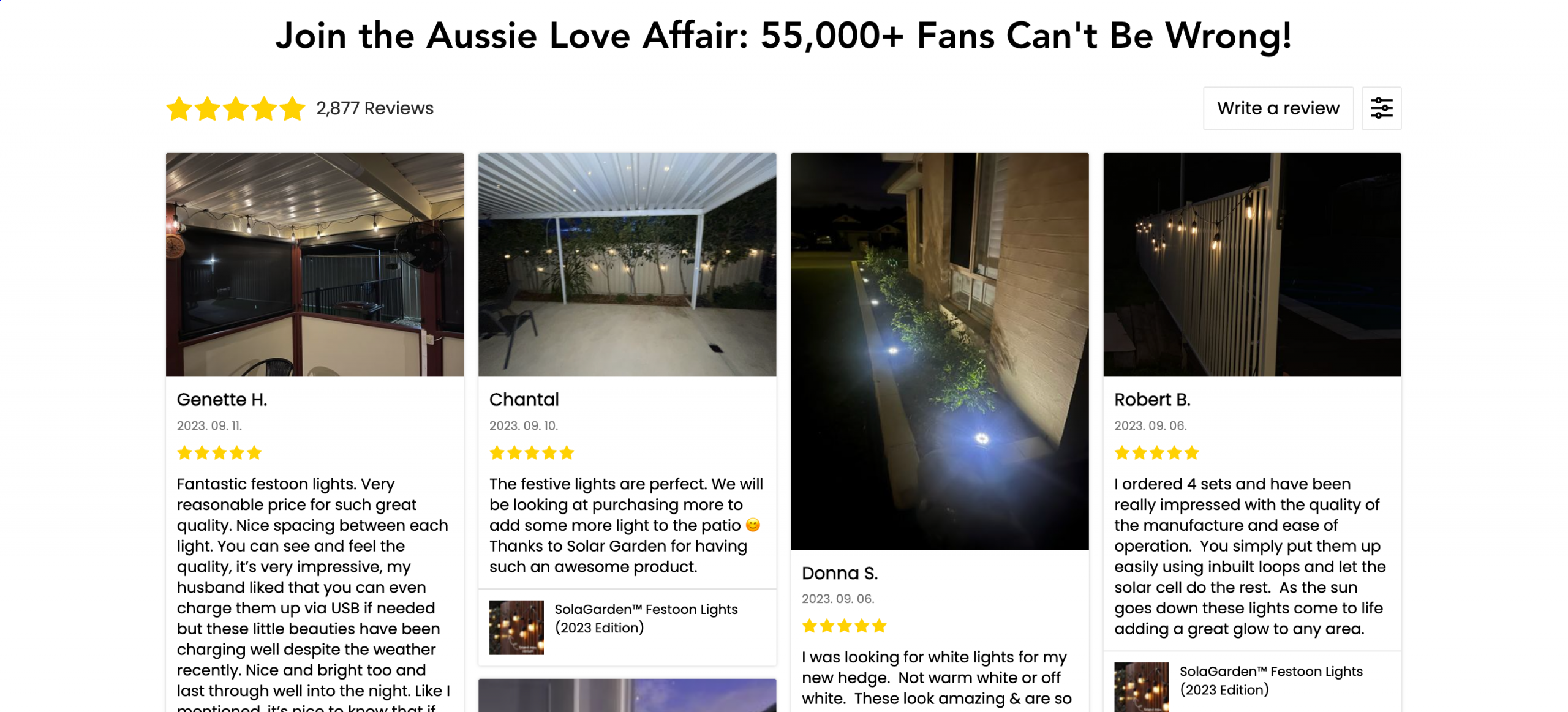
12. Implement A/B Testing
A/B testing is a crucial component of website optimization. It allows you to compare different elements on your website and make data-driven decisions to improve conversion rates.
For example, you can test a few different versions of a landing page headline to see which version performs best. The same goes for images, button colors, and layouts.
It can be difficult to know what will resonate best with your audience even if you have great marketing instincts, which is why A/B testing is essential.
13. Analyze and test continuously
Website optimization isn’t a one-and-done deal, you should be aiming for ongoing improvement. That means you should regularly analyze website data, Google Analytics, and user behavior to identify areas for improvement.
Many website optimization tools have everything you need to make data-driven decisions and improve website performance. Heat maps and user behavior analytics can help you continually refine your user experience and stay on top of changing customer needs and preferences.
Top 4 website optimization tools
Let’s take a quick look at the 4 best website optimization tools in 2023!
1. OptiMonk
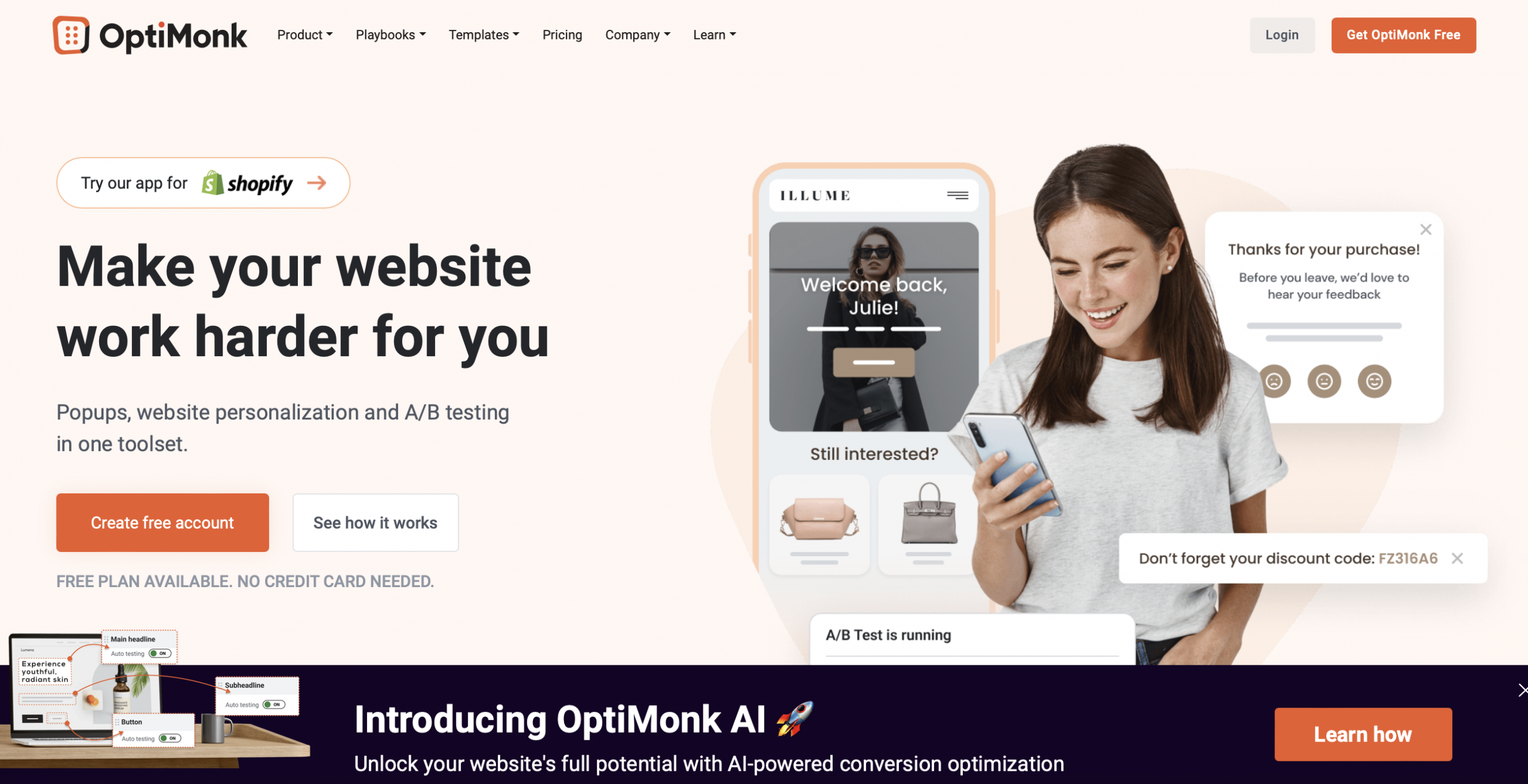
OptiMonk is an all-in-one conversion rate optimization platform that uses AI to take your website performance to new levels. And best of all, it delivers stunning results without requiring loads of time or effort from you.
This conversion rate optimization tool was custom built for marketers who want to use data-driven methods to improve their site, but can’t bring in a dedicated CRO team.
Here’s a preview of OptiMonk’s AI-powered website optimization tools.
Smart Personalizer
Smart Personalizer dynamically creates a custom landing page for each visitor, ensuring seamless alignment between the messaging in your ads and your landing page content. Make sure your incoming traffic is greeted with highly relevant content to encourage more engagement!
Smart Product Page Optimizer
OptiMonk’s Smart Product Page Optimizer, driven by AI, can elevate your product detail pages into high-converting sales platforms. This AI-driven tool crafts compelling headlines, descriptions, and benefit lists, establishing meaningful connections with your audience.
Unlock AI’s potential to curate engaging content and conduct simultaneous A/B tests across multiple product pages.
Smart A/B Testing
OptiMonk’s A/B testing feature takes the difficult task of improving your home page and landing pages and puts it on autopilot. The machine learning algorithms that make this website optimization tool possible have been trained on top ecommerce websites, learning how to create winning headlines, unique selling propositions, and product descriptions automatically.
Once our AI has crafted these elements, it runs A/B tests to discover the optimal combination.
Additional benefits:
- Access to a vast template library: Explore over 300 beautifully designed, mobile-friendly templates, all available at no additional cost.
- Intuitive drag & drop builder: Craft unique popups and embedded campaigns effortlessly with our user-friendly, no-code editor.
- Ecommerce-specific functionalities: Enjoy a range of classic and innovative features, including an impactful countdown timer, auto-generated coupon codes, and WordPress-specific targeting options.
- Customizable input fields: Gather diverse data beyond basic contact information with versatile campaign forms.
- 30+ intelligent targeting features and triggering options: Target exactly who you want using a variety of targeting options, from URL-based to cart value and traffic source-based options.
- Google, AdBlock & GDPR compliance: Rest assured that OptiMonk campaigns are fully GDPR compliant and compatible with Google’s requirements, ensuring both you and your customers are safe and secure.
- Comprehensive analytics & insights: Gain deep insights into campaign performance and user behavior to refine your strategies.
- Smart Headline Generator: Harness AI-powered creativity with our Smart Headline Generator for attention-grabbing headlines.
- 30+ email, CMS, and ecommerce integrations: Seamlessly link with popular solutions like Google Analytics, Klaviyo, and HubSpot to transfer lead data automatically and enable more targeted email marketing.
Pricing: Freemium. Essential plan available from $39/month.
2. VWO (Visual Website Optimizer)
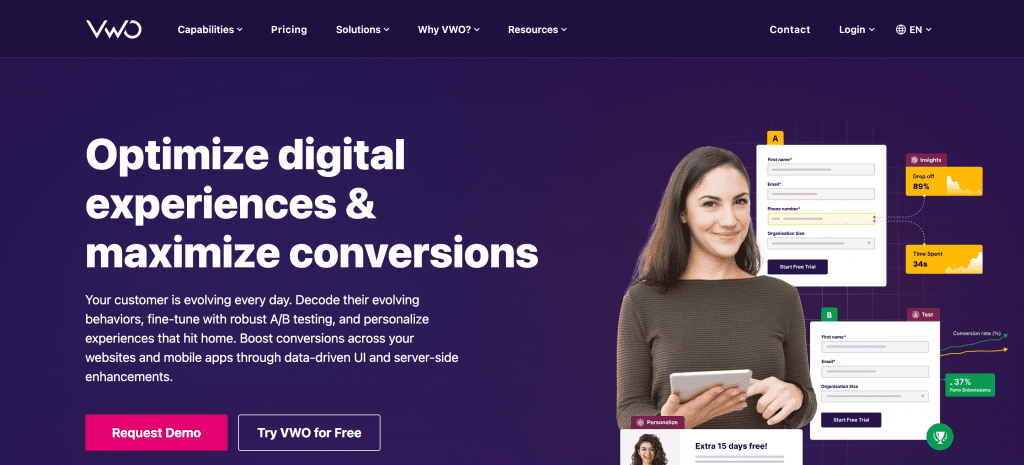
VWO provides a versatile toolset for website optimization: A/B testing, split URL testing, and multivariate testing. Its user-friendly drag-and-drop editor streamlines the process of creating test variations, enabling easy performance evaluation with various design and content elements for ecommerce sites.
Pricing: The starter pack is free. Pricing starts at $308/month.
3. Crazy Egg
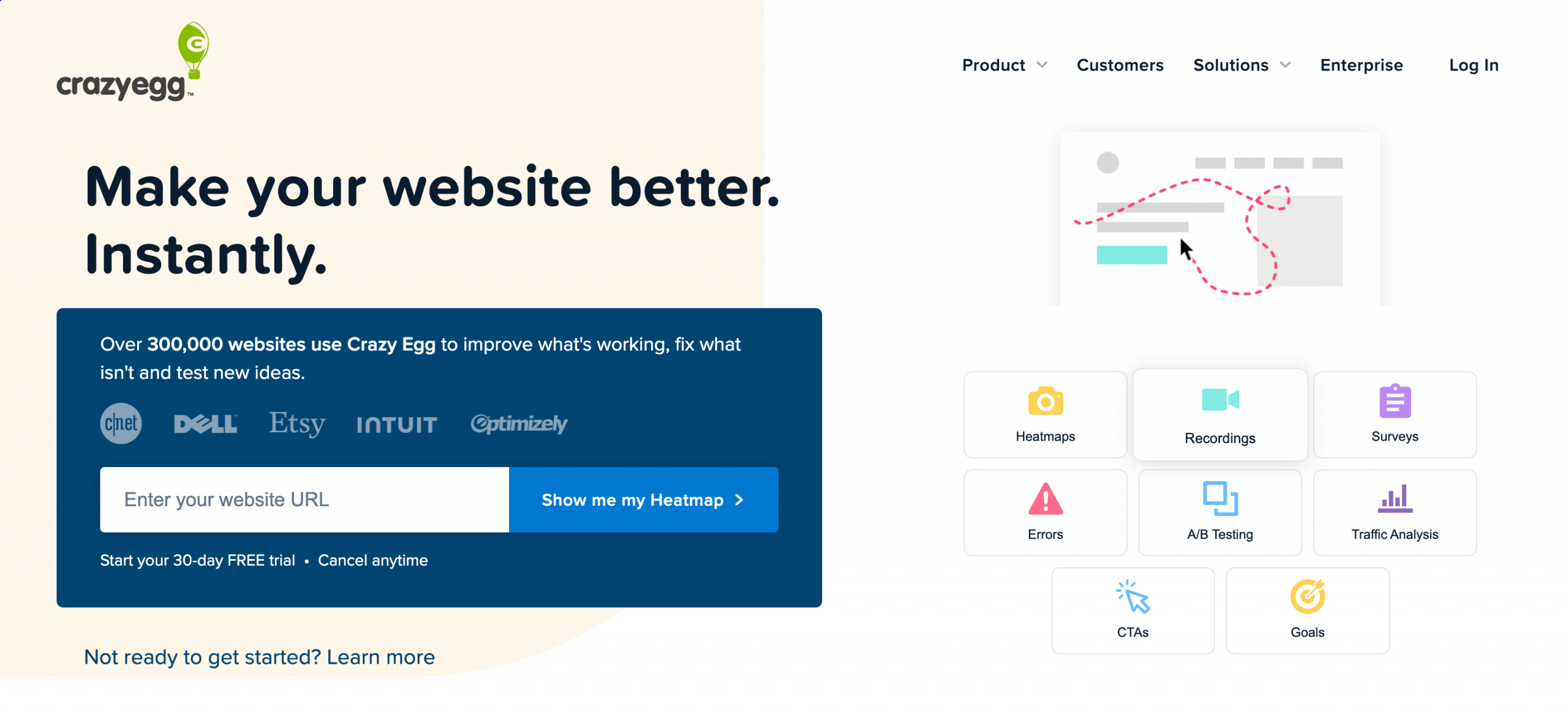
Crazy Egg presents an array of powerful features, including heatmap analysis, A/B testing functionality, and robust user behavior tracking and analysis tools. These capabilities combine to offer invaluable insights for optimizing websites.
With Crazy Egg’s heat map tools, you can easily visualize and comprehend user interactions on your website.
Pricing: Available upon request.
4. Optimizely

Optimizely stands out with its user-friendly interface, catering to both novices and seasoned experts in A/B testing and experimentation. Its comprehensive capabilities streamline A/B test creation and management, enhancing both customer experiences and conversion rates.
Incorporating advanced analytics and precise targeting options, Optimizely empowers organizations to confidently make data-driven decisions, ensuring a competitive edge as they optimize their digital presence.
Pricing: Available upon request.
FAQ
How often should I optimize my website?
Website optimization is an ongoing process. You should regularly monitor and analyze your website’s performance so that you can find and address any “leaky” sections of your sales funnel. Additionally, ecommerce moves quickly, which means you need to constantly adapt to changing user trends and expectations.
In 2023, ecommerce store owners should continuously make improvements to stay competitive.
What aspects of a website are optimized?
Website optimization covers a range of aspects, including design, functionality, content, and performance. On-page optimization focuses on creating a seamless user experience by improving navigation, load times, and content quality, while technical SEO optimization aims at boosting your ranking in Google search and other search engines.
There are other types of website optimization as well, such as mobile optimization (which includes mobile-first indexing and web accessibility).
How does website optimization benefit ecommerce businesses?
Ecommerce businesses benefit from website optimization in many ways: it helps attract more visitors, convert them into customers, and provide a satisfying online shopping experience. This can lead to increased revenue and customer loyalty.
Conclusion
Website optimization can seem daunting, but with the right optimization tools and a step-by-step approach, you can radically improve your website performance. You should direct your optimization efforts towards the most pressing issues you’re having on your website, focusing on page speed if your site is running slowly or taking a look at your Google search console to work on your on-page SEO.
If you’d like to implement any of the website optimization strategies we’ve gone over, sign up for an OptiMonk account today!









